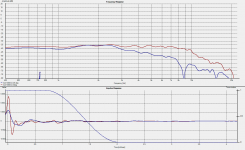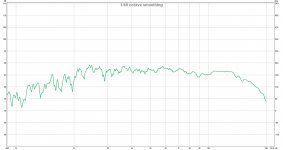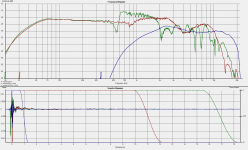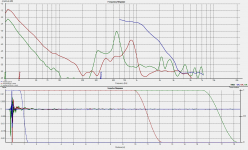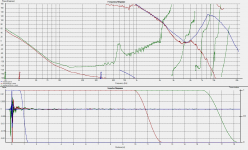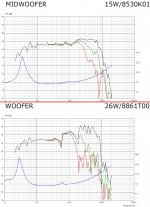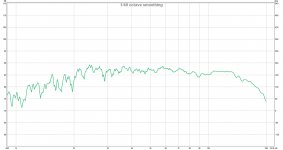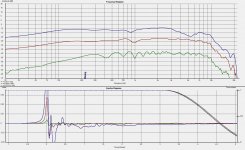I need to decide on the crossover points for the 3-way I've made. The crossovers will be active LR 24dB/octave electrical throughout (I'm aware that experts would likely favour a less generic approach, but I'm a noob taking his first steps so the simplicity is helpful at the moment and could be refined/replaced later. There will also be EQ and baffle step correction, but as separate modules rather than part of this crossover design). So to that end, I've tried to achieve smooth, flat responses throughout the potential crossover points and then to measure the responses in reality. I've arrived at a preliminary decision, but wanted to check if more experienced people can see any problems.
These are near-field measurements for my actual drivers in the actual cabinet; green=bass (26W/8861T01), red=mid (15W/8530K01) , blue=tweeter (D2608), shown wrt amplitude, THD and then phase:



(The amp volume wasn't consistent across the drivers). My inexpert interpretation is as follows:
To avoid correction, the Bass driver would be best used below about 500Hz where the sudden dip appears, so I should crossover about an octave lower ~approx 250Hz or less (the off-axis response, not shown, is fine until about 1kHz so no probs there).
The mid (technically a mid/bass driver) looks very flexible at the low end, flat down to about 90hz or less (I have it in a box giving Qtc of 1 so there is a slight rise below that). Simulations (not shown) suggest 90Hz is about the lower limit due to cone excursion, too. So, an octave above that (to keep it flat through most of the crossover region) would suggest a lower limit of around 180Hz. Hence the lower crossover should be above 180Hz for the mid and below 250Hz for the bass; I'm thinking 250Hz would be a better division of power between the drivers so thats my proposal.
The mid is very pleasing right up to about 2.5Khz. A measurement outdoors at 1m shows that the high frequency roll off is better/flatter than the near-field measurement indicates (@2m is very similar to 1m so its reasonably flat by the listening position.):

However it still begins to fall away off-axis at a similar frequency. I'm willing to allow some off-axis compromise, say through the crossover region, but want flexibility of listening position so don't want it to start dropping off much below the crossover. Probably the crossover should be at about 2.5kHz or lower from the mid's POV then.
The tweeter is the former peerless HDS which I know people on here use as low as 1.5kHz. I have it in a modest waveguide - its not so apparent near-field, but by 1m you can see the response is much flatter:

However, it does begin to roll off gently say below ~2kHz in my setup (I have a 33uf protection capacitor in series with the tweeter which may be contributing; the CR point of that would be about 600Hz but with a gentle slope). Distortion is also progressively worse, the optimum for that would be >3.5kHz.
So the upper XO point is a compromise between the mid's off-axis performance and the tweeter's roll off + distortion. Under the circumstances I feel the tweeter's roll off is gentle enough that the slight asymmetry within the 24dB/octave electrical crossover point would 'probably' be acceptable without the need for correction, so I'm probably going to plump for 2.5kHz. Above that point the tweeter's THD is still better than the worst of the mid-range's so it doesn't seem excessive.
Sorry, that post got much longer than intended! Do my 250Hz and 2.5kHz choices seem reasonable?
Thanks
Kev
These are near-field measurements for my actual drivers in the actual cabinet; green=bass (26W/8861T01), red=mid (15W/8530K01) , blue=tweeter (D2608), shown wrt amplitude, THD and then phase:
(The amp volume wasn't consistent across the drivers). My inexpert interpretation is as follows:
To avoid correction, the Bass driver would be best used below about 500Hz where the sudden dip appears, so I should crossover about an octave lower ~approx 250Hz or less (the off-axis response, not shown, is fine until about 1kHz so no probs there).
The mid (technically a mid/bass driver) looks very flexible at the low end, flat down to about 90hz or less (I have it in a box giving Qtc of 1 so there is a slight rise below that). Simulations (not shown) suggest 90Hz is about the lower limit due to cone excursion, too. So, an octave above that (to keep it flat through most of the crossover region) would suggest a lower limit of around 180Hz. Hence the lower crossover should be above 180Hz for the mid and below 250Hz for the bass; I'm thinking 250Hz would be a better division of power between the drivers so thats my proposal.
The mid is very pleasing right up to about 2.5Khz. A measurement outdoors at 1m shows that the high frequency roll off is better/flatter than the near-field measurement indicates (@2m is very similar to 1m so its reasonably flat by the listening position.):
However it still begins to fall away off-axis at a similar frequency. I'm willing to allow some off-axis compromise, say through the crossover region, but want flexibility of listening position so don't want it to start dropping off much below the crossover. Probably the crossover should be at about 2.5kHz or lower from the mid's POV then.
The tweeter is the former peerless HDS which I know people on here use as low as 1.5kHz. I have it in a modest waveguide - its not so apparent near-field, but by 1m you can see the response is much flatter:
However, it does begin to roll off gently say below ~2kHz in my setup (I have a 33uf protection capacitor in series with the tweeter which may be contributing; the CR point of that would be about 600Hz but with a gentle slope). Distortion is also progressively worse, the optimum for that would be >3.5kHz.
So the upper XO point is a compromise between the mid's off-axis performance and the tweeter's roll off + distortion. Under the circumstances I feel the tweeter's roll off is gentle enough that the slight asymmetry within the 24dB/octave electrical crossover point would 'probably' be acceptable without the need for correction, so I'm probably going to plump for 2.5kHz. Above that point the tweeter's THD is still better than the worst of the mid-range's so it doesn't seem excessive.
Sorry, that post got much longer than intended! Do my 250Hz and 2.5kHz choices seem reasonable?
Thanks
Kev
Attachments
Last edited:
Hi, the first 3 images don't show ?
Did you use a calibrated mic ?
Why Qtc @ 1 for the mid ?
Anyway, the mid off axis looks fine to me, even @ 3.5kHz - 4kHz, so i would try there, as the tweeter appears better there too.
250Hz for the B/M xover should be ok.
What type of bass box is it ?
Did you use a calibrated mic ?
Why Qtc @ 1 for the mid ?
Anyway, the mid off axis looks fine to me, even @ 3.5kHz - 4kHz, so i would try there, as the tweeter appears better there too.
250Hz for the B/M xover should be ok.
What type of bass box is it ?
Yeah, looks very reasonable. 24dB/oct gives you some breathing room. You might consider making the baffle step switchable, or maybe adjustable. Works in some rooms, less well in others.
All good fortune,
Chris
All good fortune,
Chris
Thanks everyone, very much appreciated! There are likely to be future changes to the entire project (cabinet and all) as my experience grows, but its helpful to know things aren't way off the mark to begin with; it'll give me a good basis to improve from
To respond to some of the points/questions raised:
Zero D - thats odd, I can see all the images in the post itself, although only the last two show up at the bottom as attachments. I don't know what happened there, as all the images were certainly uploaded to the forum. I think its too late for me to try editing the post to reload :-/
Yes the mic was calibrated, it was pretty flat anyway but I made sure to load the cal file to the measuring software.
The Qtc of 1 for the mid was really because as a noob I was hesitant to stray too far from normal Qs. In reality the measurements support the modelling - Qtc doesn't have much effect until well below the range I'm intending to use the mid at, so I could probably have used a higher Q/smaller-enclosure.
Its interesting what you say about the mid's off axis performance; I guess yes its only about 7dB down at 4kHz and 45 degrees is quite a long way off axis so maybe theres a bit more freedom than I'd suggested up there.
The bass box is a sealed type. You'll probably notice the roll off is unusually steep for that, but again its because I went with a higher Qtc - this time (thanks to kind advice from forum members) because it reduces volume significantly, at the cost of needing EQ to get a response more like a Qtc of 0.5.
Pete, thanks for the suggestion. It was my intention to cross over at the baffle step originally, but it would be around 360Hz IIRC, which would bring the bass driver's upper-end messiness more into the pass band. As its an active system I thought it would be better to just add a separate baffle step circuit, but possibly I'm wrong as I've not used one before.
Sreten and Chris, thanks again for the reassurance, very helpful. Chris, yes I've a few doubts about the baffle step correction at this point; probably it would be worth measuring the system after the crossovers are implemented to see if its needed. So far, outdoor measurements suggest there may be a gentle effect as expected, but in-room it was dominated by reflections and room gain. I was considering using software to equalise for the room response, as that will differ from location to location, possibly it could also cope with baffle step at the same time.
Thanks again to everyone,
Cheers
Kev
To respond to some of the points/questions raised:
Zero D - thats odd, I can see all the images in the post itself, although only the last two show up at the bottom as attachments. I don't know what happened there, as all the images were certainly uploaded to the forum. I think its too late for me to try editing the post to reload :-/
Yes the mic was calibrated, it was pretty flat anyway but I made sure to load the cal file to the measuring software.
The Qtc of 1 for the mid was really because as a noob I was hesitant to stray too far from normal Qs. In reality the measurements support the modelling - Qtc doesn't have much effect until well below the range I'm intending to use the mid at, so I could probably have used a higher Q/smaller-enclosure.
Its interesting what you say about the mid's off axis performance; I guess yes its only about 7dB down at 4kHz and 45 degrees is quite a long way off axis so maybe theres a bit more freedom than I'd suggested up there.
The bass box is a sealed type. You'll probably notice the roll off is unusually steep for that, but again its because I went with a higher Qtc - this time (thanks to kind advice from forum members) because it reduces volume significantly, at the cost of needing EQ to get a response more like a Qtc of 0.5.
Pete, thanks for the suggestion. It was my intention to cross over at the baffle step originally, but it would be around 360Hz IIRC, which would bring the bass driver's upper-end messiness more into the pass band. As its an active system I thought it would be better to just add a separate baffle step circuit, but possibly I'm wrong as I've not used one before.
Sreten and Chris, thanks again for the reassurance, very helpful. Chris, yes I've a few doubts about the baffle step correction at this point; probably it would be worth measuring the system after the crossovers are implemented to see if its needed. So far, outdoor measurements suggest there may be a gentle effect as expected, but in-room it was dominated by reflections and room gain. I was considering using software to equalise for the room response, as that will differ from location to location, possibly it could also cope with baffle step at the same time.
Thanks again to everyone,
Cheers
Kev
I like your logic in arriving at possible crossover frequencies.
Certainly worth trying and listening/measuring.
The mid Q=1 will raise the lower end of the mid response.
This will in part give you a baffle step correction without any additional EQ. It may be too "narrowband" cf the wide very slow change that the baffle step gives and required by the correction circuit to compensate.
It's not the way I would do it, but it may be enough to fill in the little hole as the bass only takes over.
I'm not sure what the phase of the baffle step cf the Q=1 or Q= to some value would be like. The measurement may show the effect after you combine the two drivers.
Certainly worth trying and listening/measuring.
The mid Q=1 will raise the lower end of the mid response.
This will in part give you a baffle step correction without any additional EQ. It may be too "narrowband" cf the wide very slow change that the baffle step gives and required by the correction circuit to compensate.
It's not the way I would do it, but it may be enough to fill in the little hole as the bass only takes over.
I'm not sure what the phase of the baffle step cf the Q=1 or Q= to some value would be like. The measurement may show the effect after you combine the two drivers.
ask the Mod's to substitute the new corrected post1 for the existing.
Don't ask them to change post1.
Don't ask them to change post1.
Thanks Andrew, good to get the reassurance, and interesting to think about the mid's Q in that way - its not something I did for that reason but it may be of benefit.
Zero D. The in-line pictures show up for me using my main internet connection, but if I tether a mobile phone as a modem they don't show, just the attachments at the bottom and then only two of five. So weird things are clearly going on, but I can't see anything wrong with the post so I'm going to re-attempt to attach them to this one:
Amplitude

THD

Phase

Let me know if this doesn't work for you,
Kev
Zero D. The in-line pictures show up for me using my main internet connection, but if I tether a mobile phone as a modem they don't show, just the attachments at the bottom and then only two of five. So weird things are clearly going on, but I can't see anything wrong with the post so I'm going to re-attempt to attach them to this one:
Amplitude
THD
Phase
Let me know if this doesn't work for you,
Kev
Attachments
Thanks, Andrew - thats good to know.
Odd, I don't recall doing anything differently in the OP. Still, if they've worked this time that should be fine.
Cheers,
Kev
Odd, I don't recall doing anything differently in the OP. Still, if they've worked this time that should be fine.
Cheers,
Kev
are you driving all three speakers when measuring one of them?
It might help testing each one completely separately. There seems to be a lot of interaction that I don't understand, but it could be phase differences causing nulls and peaks.
What is that green anomaly from 500Hz to 600Hz?
And if blue is measured alone does that response shape stay the same?
What is the red anomaly from 2400Hz to 4900Hz?
It might help testing each one completely separately. There seems to be a lot of interaction that I don't understand, but it could be phase differences causing nulls and peaks.
What is that green anomaly from 500Hz to 600Hz?
And if blue is measured alone does that response shape stay the same?
What is the red anomaly from 2400Hz to 4900Hz?
Hi Andrew, I only drove/tester one driver at a time, I didn't want them interacting and fudging the measurements. I will test them together, as a system, but only after the crossover has been installed.
The green anomaly between 500-600Hz is one reason for my decision to cross over an octave lower. I don't know specifically what causes it, but its there in the manufacturer's FR chart too, theres also a similar (though much smaller) pattern on the mid at a slightly higher frequency:

I'm not sure if the near-field amplitude response of the blue/tweeter line is misleading; I took it mostly to measure the distortion. But if one pulls the mic back a bit then the response is much flatter, and more representative of how it would be at the listening position - presumably as the waveguide comes into play. Theres this one I took at 500mm

As you can see its much flatter, if a little more wobbly. The progressively more distant readings are similar (though the higher frequencies start to attenuate more with distance).
The red anomaly you mention above 2.4kHz also seems to be restricted to the near-field measurement. Here are separate measurements I made at 25mm 200mm and 2000mm, the scale hides it a bit but as you can see it is still there at 25mm yet no longer really present at even a short 200mm distance from the baffle.

It was useful to take a near-field measurement to look at the lower end of it's range where reflections would otherwise have intruded, but as with the tweeter probably the slightly more distant measurements are more appropriate for higher frequency FR. If I had more time and skill I could have tried merging the low/near and far/high frequencies but I'm working up to that, probably be needed when I measure the complete syetem at once.
Those are my interpretations anyway, but of course I'm new to all this so could be wrong.
Cheers
Kev
The green anomaly between 500-600Hz is one reason for my decision to cross over an octave lower. I don't know specifically what causes it, but its there in the manufacturer's FR chart too, theres also a similar (though much smaller) pattern on the mid at a slightly higher frequency:
I'm not sure if the near-field amplitude response of the blue/tweeter line is misleading; I took it mostly to measure the distortion. But if one pulls the mic back a bit then the response is much flatter, and more representative of how it would be at the listening position - presumably as the waveguide comes into play. Theres this one I took at 500mm
As you can see its much flatter, if a little more wobbly. The progressively more distant readings are similar (though the higher frequencies start to attenuate more with distance).
The red anomaly you mention above 2.4kHz also seems to be restricted to the near-field measurement. Here are separate measurements I made at 25mm 200mm and 2000mm, the scale hides it a bit but as you can see it is still there at 25mm yet no longer really present at even a short 200mm distance from the baffle.
It was useful to take a near-field measurement to look at the lower end of it's range where reflections would otherwise have intruded, but as with the tweeter probably the slightly more distant measurements are more appropriate for higher frequency FR. If I had more time and skill I could have tried merging the low/near and far/high frequencies but I'm working up to that, probably be needed when I measure the complete syetem at once.
Those are my interpretations anyway, but of course I'm new to all this so could be wrong.
Cheers
Kev
Attachments
Hi, the ones in the first post still don't show ? Since & including Post # !0 i can see All later images. Wierd !
Hi, thanks for the info. Yeah something wierd indeed. Its like the images got uploaded but somehow lost their association with the post.
Anyhow, the images in post #10 are replicas of what should have been the first three images in #1 so I'm glad you can see them.
Thanks again
Kev
Anyhow, the images in post #10 are replicas of what should have been the first three images in #1 so I'm glad you can see them.
Thanks again
Kev
- Status
- Not open for further replies.
- Home
- Loudspeakers
- Multi-Way
- Choosing crossover points
